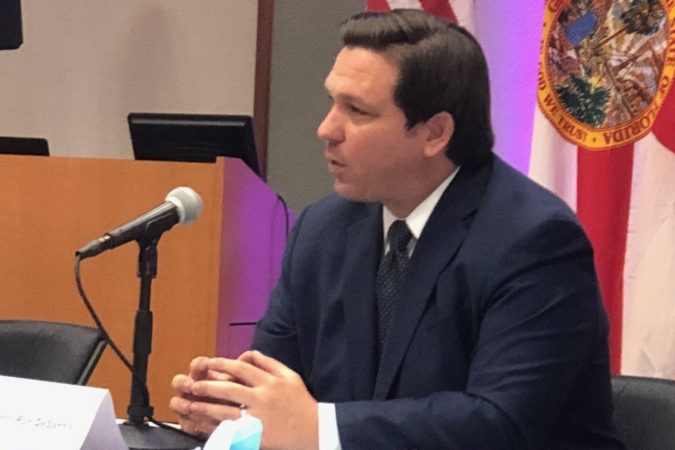
By Jim Saunders, The News Service of Florida
TALLAHASSEE — Gov. Ron DeSantis on Thursday proposed a record $96.6 billion state budget for the upcoming fiscal year, offering a more upbeat picture of Florida’s finances than lawmakers who will have to stitch together a spending plan as the COVID-19 pandemic continues to hamper the economy.
During a news conference at the Capitol, DeSantis said his proposal would increase funding for public schools, continue funneling money into environmental issues such as Everglades restoration and direct dollars to initiatives like helping address sea-level rise.
But the proposal was a departure from projections that the state could face a more than $2 billion budget shortfall because of the economic fallout of the pandemic. Legislative leaders have warned repeatedly that they expect to have to make budget cuts as they negotiate a spending plan for the fiscal year that starts July 1.
DeSantis’ proposal — dubbed the “Florida Leads†budget — is a starting point for the legislative deliberations, and it relies heavily on federal money that has flowed into the state to help deal with the pandemic. Also, it would bank on such things as increased property-tax revenues to boost education spending, long a controversial issue.
The proposal would be about $4.3 billion higher than the current year’s budget. A summary of the proposal released by DeSantis’ office said $2.6 billion of the potential increase is related to the COVID-19 response or impacts of the pandemic.
“Despite the unprecedented circumstances and historic reductions, the Florida Leads budget for fiscal year 2021-2022 totals more than our current budget for the last year,†DeSantis said. “It’s $4.3 billion more. Most of that is directly related to COVID response efforts.â€
But as recently as mid-January, House Appropriations Chairman Jay Trumbull, R-Panama City, warned of looming budget cuts, including the possibility of education cuts. Senate President Wilton Simpson, R-Trilby, also has raised the possibility of moves such as increasing university tuition — something not included in DeSantis’ proposal.
“You know, we’re going to need to look very hard and diligently at how everything is funded, and whether or not it meets muster. … And we will be squeezing blood out of turnips, as they say in my neck of the woods,†Trumbull said this month.
House Minority Co-leader Evan Jenne, D-Dania Beach, described DeSantis’ budget proposal Thursday as a “wish list.†The annual legislative session starts March 2, but committees are scheduled next week to start reviewing the proposal.
“The governor’s proposed budget holds no sway, when it comes to when things are actually being done,†Jenne said. “Obviously, priorities will be prioritized for his benefit. But, in terms of the overall structure of things, it is really just political theater to make people feel like the economy is doing better than it actually is.â€
Among the factors increasing the proposed budget’s bottom line is a surge of hundreds of thousands of people enrolling in the Medicaid program as they have lost jobs or need health-care coverage. Medicaid is expected to include about 4.59 million people during the upcoming year, with the increased enrollment reflected in higher costs for the program, which is jointly funded by the state and federal governments.
DeSantis’ proposal addresses myriad programs and issues across state government. Some high-profile parts of the proposal include:
— An additional $285.5 million for the main part of public-school funding, with an increase of $233 per student. About $217 million of the $285.5 million would come from increased property-tax revenues that stem from higher property values.
— $625 million to continue a multi-year effort to restore the Everglades and address other water-related issues, including springs restoration. The proposal also includes a new “Resilient Florida†program, which would involve issuing bonds to help the state and local governments address issues such as sea-level rise.
— $50 million for the Visit Florida tourism-marketing agency, which has been the subject of years of battles in the Legislature. Also, the proposal would provide $50 million for the “Job Growth Grant†program, an economic-development program.
— An eight-day tax “holiday†that would allow back-to-school shoppers to avoid paying sales taxes on clothes, school supplies and computers. Also, the proposal would provide a 10-day tax holiday for purchases of disaster-preparedness supplies.
— No across-the-board pay raises for state employees.
News Service Assignment Manager Tom Urban contributed to this report.



